The Sepik River Trip
(Part one of
two parts.)
Overview
There
is something especially alluring about insulated groups who live their lives
with little contact with the modern world, particularly when they have rich
cultural and artistic histories. Some of the world's best opportunities for
visiting societies that meet these criteria are found in Papua New Guinea
(PNG). So off we went, mindful of the numerous travel warnings about the dangers
of the region but eager to finally visit what had been one of our ultimate
travel destinations for more than 10 years.

This trip was comprised of two parts - a river voyage on the remote Sepik River and a visit to the Highlands Sing Sing in Mt. Hagen. Each exceeded our lofty expectations. We also expected PNG to be an unpredictable and sometimes risky place and that certainly proved to be true. In this part, we describe our trip on the Sepik. Part Two will focus on the Sing Sing - in a future issue.
DAILY
SCHEDULE
DAYS 1-3
We departed San Diego for LAX at 6 pm on August 7, 2002. From Los Angeles
we flew on Qantas to Auckland, New Zealand, then on to Brisbane, Australia,
and finally to Port Moresby in Papua New Guinea, arriving at 2 pm on August
9, losing a day crossing the international date line. We arrived a day ahead
of the other members of our Adventures Abroad group, and settled in at the
very comfortable Holiday Inn. Heeding warnings from the Australian Foreign
Service and U.S. State Department web sites not to take taxis from the airport,
we had made sure to book our lodging in a hotel that offered shuttle service
to and from the airport. After getting settled, mindful of the "rascals"
(petty robbers) endemic to PNG and the many warnings about street crime in
Port Moresby, we timidly ventured out of our hotel (which like all hotels
and many businesses in the city and throughout the country is surrounded by
a secure wall topped by barbed wire) and warily walked a long block to a bank
where we obtained some local currency (called kina). We had been assured by
the hotel desk clerk that it would not be imprudent to take this short walk
in the daytime. The sidewalk along the way was splattered and stained in red.
We joked that it was the blood of accosted tourists, but it soon dawned on
us that the color was from betel nut, a wildly popular chewing pastime in
PNG and a number of Asian countries.
When chewed in the right proportions with lime and mustard bean, the mixture produces a mild high and badly stains the lips, gums, and teeth of the chewer a bright red. The habit typically begins in early childhood and is nearly universal.
Betel nut is a product of a relatively common, tall, thin palm tree, and the nuts along with mustard bean and lime can be found in markets throughout the country. Users shed the husks from the nuts just before chewing and the husks litter the ground everywhere.

Chewing Betel Nuts
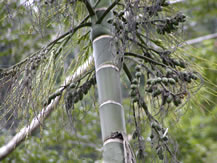
Betel
Nut Tree
Leaving the bank, we visited a nearby "hypermarket." Typical of several similar establishments we saw in PNG, this is a kind of general store with a concrete floor and a wide variety of groceries and other goods. We purchased ice cream bars and then watchfully made our way back to the hotel, feeling like we had achieved a victory of sorts by returning safely. We did not venture out again. (There was actually a 10 pm curfew in Port Moresby as recently as 1997.)
DAY
4
We awoke the next morning to a surprisingly fresh breeze, permitting us to
keep our patio door opened. After breakfast, the hotel airport shuttle transported
us directly to the Airways Hotel where we were to meet our fellow tour members
and spend our second night in PNG. Our room at the Airways, while not as nice
as that at the Holiday, was still quite comfortable, and the hotel featured
an extremely pleasant open-air top level restaurant overlooking the airport
runway, about a half a mile away. Soon after our arrival we received a call
from our Adventures-Abroad tour leader (Martin) letting us know that he and
the other members of our group would be delayed by 8 hours in their departure
from Cairns, Australia and would be arriving around 8 pm.
Faced with a good bit of extra time on our hands, curiosity got the best of us (at least the best of Larry) and we decided to venture downtown. We asked the airport shuttle drivers to call a taxi for us. They hopped in the shuttle van, drove to the airport, and returned a few minutes later followed by our taxi. It seems that there is no such thing in Port Moresby (and probably in the entire country) as a radio taxi. We agreed on a fare with the driver and 20 minutes or so later, after a featureless ride, we were dropped off at the Crown Plaza, Port Moresby's premier hotel (and tallest building at about 10 stories) overlooking the Coral Sea. We were met by a friendly security guard who first disapprovingly advised us that we overpaid for the taxi and then assured us that it would be safe to take a short walk through the downtown. He said he would have been glad to accompany us if he were not on duty. We tenuously made about a 6-block circular tour from the hotel and back through the incredibly nondescript and charmless downtown core, which was nearly deserted on a Saturday afternoon. When we returned, we asked the concierge to secure a taxi for us. A lower ranking security guard was assigned this task. He invited us to have a seat in the lobby and then cheerfully stood on the street corner for nearly 45 minutes until a lone taxi finally ambled by. The driver followed a totally different return route and though he seemed friendly enough, we were a bit uneasy and were relieved to see the airport area come into view. So the hypermarket and downtown were our first two exciting forays in not yet exotic PNG. We had a leisurely buffet dinner in the open-air restaurant (which included cooked to order seafood selections) while we awaited our group. On the far side of the restaurant, some sort of strange kick-boxing performance was staged. We learned from a pair of congenial Australian businessmen that most of the air traffic between Port Moresby and Australia is accounted for by Australians associated with the oil and timber industries in the Highlands. There were few tourists in sight. We later learned from talking with other Australian businessmen that Aussies rarely view PNG as a tourist destination. When our group finally arrived, we learned that we were scheduled for an early morning departure -- easier for us than for our exhausted travel companions. The group, which included 3 Brits, 4 Canadians, and 7 Americans, was well-traveled, having visited such off the beaten track countries as Madagascar, Ethiopia, Iran, Oman, Mongolia, Namibia, Mali, Senegal, Libya, and the Antarctic. One participant had flown 5 times on the Concorde.
DAY
5
When we arrived at the Port Moresby airport at 5 am for our flight to Madang,
our tour leader was advised that we were going to be moved to an evening flight
because the plane was overbooked. That would mean another entire day in Port
Moresby rather than a day at the highly regarded Madang Resort Hotel -- a
potential mini-disaster. However, one large group failed to show and the seats
were ours. (These types of things apparently happen all the time in PNG.)
Madang was one of many places in New Guinea where fierce fighting occurred
between the Allied forces and the Japanese in World War II. On the way to
the resort from the airport, we saw the remains of a number of Japanese machine
gun emplacements sitting right on the edge of the Bismarck Sea. Several bomber
crash sites can be visited in the region and others can be explored under
the sea.
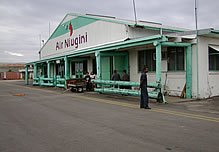
Madang Airport
The Madang Resort, which may be the country's best, sits on an attractive peninsula at the edge of the Bismarck Sea. It is an extensive complex with beautiful tropical grounds and world class dive sites nearby. (The water in the bay is about 79° Fahrenheit.) One of the contributing factors to the exotic feel here is the presence of fruit bats that roost in the treetops in huge numbers and, as bats do, hang upside down. (They are also called flying foxes.) They are strictly vegetarian and lack the sonar that many other species of bats possess. Apparently, a number of species of fruit trees are almost totally dependent upon the bats for pollination. They are quite noisy so you are continually aware of their presence. The resort offers a variety of types of lodging arrangements but the premier accommodations are a series of delightful individual seafront cottages, so close to the water that waves lap against the patio door. And we, along with most of our group, were fortunate enough to be assigned one of these units.
Judi was happy to find a rather large thatch-sheltered handicrafts market right on the resort grounds. Here we got our first look at PNG crafts, which included carved wooden masks and crocodiles, colorful hand bags (called billums) woven from plant fibers, and jewelry made of seeds and shells. In striking contrast to the markets of the Middle East and South America, there is no real bargaining for crafts in PNG. An artist or vendor may propose a "second price." If not, you pay what is asked or walk away. Offering a lower price is considered exceedingly rude. But it doesn't matter because crafts prices are scandalously cheap. Simple necklaces and bracelets are 1 or 2 kina (a kina is about 30 cents). Small masks start at 3 kina and larger ones (10 to 12 inches high) begin at about 5 or 6 kina. Nice billums start at about 30 kina.
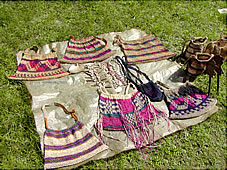
Colorful Billums
DAY
6
Having a free morning, we walked a few blocks to check out the Madang town
center in hopes of discovering something interesting or at least another store
to get ice cream bars. The unattractive town center contrasts sharply with
the gracious grounds and extensive plantings at the resort. We felt quite
safe among the many natives in this small town who seemed to go out of their
way to smile and say hello. The pay phones outside of the telephone company
office were among a number where we unsuccessfully attempted to place a calling
card call to the US. We stopped at the Air Niugini office to see if we could
book an earlier flight out of Port Moresby at the end of our stay. But, predictably,
the airline's computers were down. So we checked out the town market in a
nearby park. In addition to many exotic fruits and vegetables, there were
crafts, and probably more tourists than we saw elsewhere in PNG (except at
the Sing Sing), most no doubt lured by Madang's reputation for underwater
activities.
In the afternoon, we boarded a bus for a ride along the south coast highway. We stopped first at a cultural center, then at a betel nut market, and then continued to the Balek Nature Preserve which featured a wide variety of exotic orchids, trees and plants (e.g., wild mandarin, wild pepper). The preserve also contained a picturesque sulfurous grotto that served as the setting for the grave site of Man Friday in the most recent movie remake of Robinson Crusoe.

Exotic Flower
Balek Reserve
We stopped next at Bilbil Village, spectacularly situated right on the Bismarck
Sea. The rocky coast reminded us of the coastline at Monterey. The village
is known for its hand-turned clay pottery. A colorful Sing Sing (our first)
was arranged for us. All of the women performers were bare-breasted.
When we subsequently visited the Sepik River villages, we learned that this form of dress is common to everyday village life, for perhaps half of the women. As we headed back to Madang at 4:30 pm, it was still very sultry, but the temperature had dropped to a level that made conditions surprisingly pleasant. We proceeded directly to the MTS Discoverer, which was to be our home for the next 5 days.
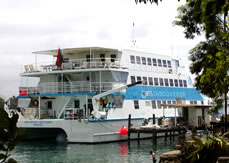
MTS
Discoverer
Once aboard, we were given an orientation by Brian, the ship lecturer, and assigned our cabins. The cabins, as on any ship, vary somewhat in size, number of windows, and configuration. Most but not all of our group were pleased with their quarters. We were delighted. We had two twin beds, plenty of storage space, 3 large windows, and a nice bathroom with shower and toilet. A TV monitor in each cabin permitted passengers to watch documentary videos that were shown each night at 9 pm. The departure, scheduled for 6 pm, was delayed until 10 pm because of rough seas. The crew wanted the passengers in their beds before sailing as our passage across a portion of the Bismarck Sea was expected to be rough. Little did we know what was in store for us. We fell asleep and then awoke to tossing seas. We quickly secured objects like water bottles that were flying about like missiles. It would have not been possible to stand without holding onto something for the next 6 to 8 hours. Apparently, rough crossings are quite normal but our tour company had not fully prepared us as this was also their first trip in PNG and 5 or 6 people became quite seasick during the night.
DAY
7
We arrive at Manam Island at 5 am and drop anchor. Passengers awake to a breathtaking
sight: an island of picturesque thatched dwellings surrounded by banana trees
and palms, dominated by a smoking blue-green volcano. It looks too perfect
to be real. We view our impending excursion to the island as the real beginning
to our PNG trip. At 8 am, as soon as we finish breakfast, we are transported
to the island in our 16 passenger speedboat. Villagers had lined the shore
for hours awaiting our arrival. It is very humid but mild. The crew off load
rice, as the ash that spewed from the volcano in May had seriously retarded
the village crops.
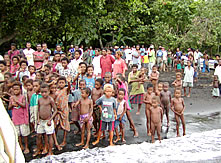
Manam Island Greeting party
We are informally welcomed by the villagers with a crafts market. This is to be replicated on many subsequent occasions. Those who speak English (perhaps 20%) are very approachable and happy to talk or answer questions. However they exhibit little curiosity about us; for example, they never ask where we are from, presumably because the answer would hold little meaning for them. From the natives, we learn some basics about life here. For the most part, what we learned here also applied to the villages we would visit once we reached the Sepik proper. There is no plumbing in the village nor any source of electricity on the island, hence no fans, radios, or television, and of course no phones. Cooking is done over wood stoves. Water is collected in buckets from the river. There are no newspapers. There is no regular boat traffic. The only visitors other than an occasional official or missionary or trader are the people who arrive every few weeks on the MTS Discoverer, our ship. There is a medical clinic (a rarity) and a school. There are no paid jobs and therefore no source of income except from selling produce to one another in the market or selling crafts to those who arrive on the Discoverer or to an occasional visiting trader arriving by motorized boat. Everyone has a garden and the crops grown by a family serve as the principal food source. Some villagers are able to earn a little income by selling coffee beans and a few other commodities to visiting traders.
Due to the Christian missionary influence, many people here have names like William, Joseph, and John. Most villagers, particularly men and boys, dress in western apparel -- mostly second-hand shirts, t-shirts and pants, apparently provided by charities. No one wears a watch. Smoking is quite uncommon but betel nut chewing is ubiquitous. A few of the villagers had traveled as far as Madang. No one had been as far as Port Moresby. We learned that it is periodically necessary to evacuate the island's residents when the volcano becomes active.

Manam
Island Family
At 9:30 we gather in an open area for an anticipated Sing Sing. But something had gone awry and the performers had not followed through on the Head Man's orders. He becomes angry and begins admonishing the villagers while standing in the large clearing. People begin to scurry away like scared rabbits -- first children, then teens, then adults, as he continues to shout in a style that we came to recognize (after seeing some documentaries) as a distinctive form of New Guinea oratory. This is a totally unstaged, authentic aspect of village life and we find it far more interesting than a Sing Sing. We learned from a villager that authority is inherited in this village and the Head Man has a son who is destined to replace him at some point. At 10 am, we bid goodbye to the villagers, including this very beguiling little girl.

Back on board the Discoverer and on our way toward the Sepik, Manam Island remains visible for over two hours, presenting a stunning scene as the clouds gather and then dissipate around the cone of the volcano. There are more volcanic peaks to the north and east.
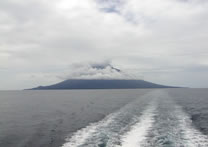
Manam Island
Just before noon, we cross a point where the waters of the Sepik can be seen spilling into the Bismarck Sea. Directly below, the water was deep blue. Ahead, it was pale green and the dividing line between the two colors was so straight it looks as if it has been drawn by a giant ruler.
In another hour we enter the Sepik River and pass the first of many movie set villages along the shore -- all thatch and palms. The heat has become pretty intense on deck but one could always escape to the coolness of the air-conditioned cabins. Within another hour, for some reason the heat abates and it becomes quite pleasant on deck in the breeze. We eagerly anticipate our next stop. The river has assumed its characteristic muddy brown color.
3:00 pm: The Discoverer comes to a stop and we board our speedboat and race toward the Majop Canal. Once in the narrow canal (or barak), we slow and then came to a dead stop. For a few moments, we sit in silence and listen to the bird calls and other sounds of the jungle. Then we resume our journey through this impossibly beautiful, palm-lined channel, ducking and weaving to avoid low hanging sago and palm fronds and the branches of breadfruit trees. We wonder if we have ever been in a place this beautiful before. After about 30 minutes we enter one of the Murik Lakes, cross it at a high speed and soon arrive at Mendam, the home village of the newly elected prime minister of PNG, Michael Somare. We entered the village through a pathway lined with attractive artifacts in anticipation of our arrival. All of the paths are covered with soft mango wood chips and shells. There is a faint rotting smell. We see large nets in the boats filled with crabs and mussels. It is very humid and there is no breeze, but the sun is behind clouds, making the temperature manageable.
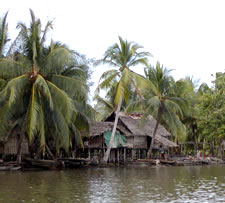
Approaching Mendam
Some villagers put on a "drama" for us that consists of 3 absolutely wonderful slapstick mini-skits, kind of a native version of the Three Stooges, but more colorful in that the performers are bedecked with shells, leaves, and feathers. The other villagers clearly enjoy it as much as we do. We meet the originator of the drama. He could pass for a distinguished academic or a statesman. On our equally gorgeous return ride back through the channel to the Discoverer, we note that this has been a spectacular day, yet only our first of four days on the river. We wonder what the next few days will offer and how we will ever be able to top this adventure.
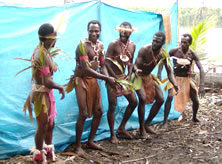
Slap stick comedy Papua Style
DAY
8
We anchored the previous evening near Bien village. The Sepik is shallow in
places and there are many islands of river grass that break off and float
freely down the river so it is not safe to travel after dark. Brian, our engaging
onboard lecturer, has not been feeling well and thinks he may have malaria.
After our usual 7 am breakfast, we depart by speedboat for a trip down a tributary
to Pankin Village. It is refreshingly cool this morning in the breeze and
some of us don windbreakers. We see many birds, including herrings, egrets,
parrots, hawks, fish eagles, a very large variety of parakeet, and cormorants.
We slow whenever we pass a village to prevent shore erosion and to avoid disturbing
fishing activity. Pankin is another picturesque subsistence village of 400.
Coffee, cocoa, and vanilla are among
the crops here. No schooling has taken place here for some time because the
school building is in disrepair and no one has gotten around to repairing
it. Sitting on a table along one of the paths is a very large green and white
speckled Cassowary egg. The Cassowary is a flightless bird about the size
of an emu. We bid the villagers goodbye. On our return run, we stop at one
point to watch a woman processing sago, a principle staple in the diet of
the Sepik region. The scene looks like something out of the pages of a 1950s
National Geographic. We return to the boat to have lunch and resume our voyage
upstream.
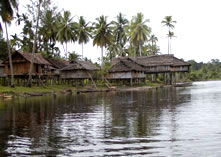
Approaching Pankin

Processing Sago
Next
we journey to Kambaramba 2, an incredibly picturesque stilt village, right
in the middle of the river. As we come to a stop we are surrounded by boys
in dugout canoes offering us rides for 1 kina. We jump at the chance. It is
very peaceful out on the water
in the canoe.

Kambaramba 2 Stilt Village
After breakfast, we board our speedboat for a trip to Angoram, the district headquarters town for the lower and middle Sepik. A Sing Sing is performed for us.
By mid-afternoon we reach Tambanam in the Middle Sepik. This region is considered the center for woodcarving. We do see a lot of carving going on here and we are impressed. Many of the masks displayed in this village are 6 to 8 feet high and seem of a high quality. We see lots of canoes, paddles, tables, and house posts that have crocodiles carved into the design. This village of about 2000 is noted for its three impressive large houses belonging to the leaders of the 3 local clans whose symbols are the pig, the crocodile, and the sago palm. The natives here are part of the Iatmul, a group studied by Margaret Mead and Gregory Bateson.
In the late afternoon, we pass the village of Timbunke that has a missionary complex with tin-roofed buildings, the most modern structures we've seen in several days. We see fires along the riverbank and hear children's voices. People can be seen carrying fire sticks. These are slow-burning twigs of some kind that stay lit all day as a substitute for matches. A David Attenborough video on crocodiles on the Sepik is announced over the speakers but we are too transfixed by the scenes from the deck to go inside. We anchor here for the night.
DAY 10
This morning, we resume our navigation upstream as far as Palembei anchorage
where we have a 30-minute walk along a canal to the village of about 500.
Along the way, we hear lots of interesting bird calls and frogs croaking and
we see profusions of water lilies. Mosquitoes are more numerous along the
canal than we have encountered elsewhere so out comes the repellant. After
making our way through a lineup of crafts, we see two major Haus Tambarans
or spirit houses. These are social and religious centers that serve as popular
gathering places for the men of the village. Women are forbidden to enter
but an exception is made for female tourists. These structures were designed
to be surrounded by water. But it has been 5 years since that occurred here.
The upper floor is jammed with all kinds of carved masks. In the center is
an Orator's Chair. When a member of the community wishes to speak, he removes
a bundle of greenery off of the chair. He then has the floor. Photos are permitted
of everything except the Orator's Chair.
We resume our journey upstream to Yenchen Village which has a large spirit house situated impressively right on the riverbank. The jungle is very lush behind this village. We hear many beautiful bird calls and wonder what other kinds of creatures are lurking nearby. There are many butterflies here and coconuts litter the ground everywhere. We then continue up the river to our westernmost stop on the Sepik, near Kanganaman village. We board our motorboat for a ride down a tributary and then through a beguiling canal to the village shore. After a 15-minute walk, we are rewarded with a view of the largest spirit house on the Sepik. We are once again in a setting too beautiful to adequately describe, with towering coconut palms, bougainvillea, brilliant hibiscus, multi-colored crotons, and fields of green.
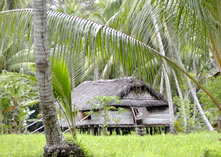
Kanganaman
House
We return to the Discoverer and travel back downstream to the village of Kaminimbit. Here we have a veritable crafts supermarket laid out for us as we disembark. This is the home village of Cyril, Brian's understudy, who is being groomed to take over for Brian in another year. We meet Cyril's mother, wife, and his two children. We are directed to a group of women from the village who have dressed in festival attire to welcome us and then we continue on to a staked compound where a group of male villagers perform an impressive flute ceremony. This performance has the look and feel of a vintage New Guinea tradition. The enclosure blocks the view of women who for some reason are prohibited from witnessing this performance.
We are given a big send off as we depart for the Discoverer. Our speedboat is crammed with some very large carvings that the crew has purchased at the request of the cultural center in Madang. We board the Discoverer and continue back downstream as far as Timbunke. Brian has not gotten any better in the past few days, but has continued to admirably perform his duties, including a nightly briefing. He has arranged to fly to Port Moresby for treatment after we depart tomorrow rather than return on the Discoverer.
End of Part 1
Watch for Part 2 in a Future Issue




